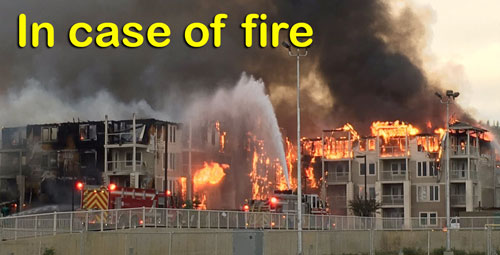
 |
| • |
Newer condos have a fire panel announcement system so security and the the firefighters can speak to all the residents when there is a fire alarm while older condos do not. |
| • |
Newer
condos may have locks on the staircase doors so you can leave hallways
but not re-enter. These buildings have cross-over floors which unlock
whenever the fire alarms are activated. Older condos and some new ones
don't have locks on the staircase doors. |
| • |
Some condo units have hard-wired smoke detectors while others use nine-volt batteries. |
| • |
Newer condos have fire sprinklers inside the residential units. Older ones do not. |
| • |
Some condos have security on-site 24 hours a day while others do not. |
| • |
Some
condo boards invite the municipal Fire Services to come to the condo to
speak to residents about safety procedures and best practices while
others do not. |
| 1. |
If anyone in your apartment has
a disability and cannot walk down the staircases, inform building
management and insure their names, unit number and disability is
included on the list that is kept in the Fire Safety Plan box. |
| 2. |
Replace your smoke detector every ten years. If you don't know how old your detector is, buy a new one. |
| 3. |
Never disconnect your smoke alarm, the heat detector unit or the alarm speaker in your apartment. Replace damaged ones. |
| 4. |
Change the batteries in your smoke detectors twice a year. Do not use cheap batteries that you can buy at discount stores. They do not last as long and they may corrode the detector's terminals |
| 5. |
If you have changed locks or
have put a second lock on your door, give
a key to the building manager. If the alarm is coming from your unit
and if you are not home, the firefighters may tear open your door with
a special crowbar-type tool. This will destroy the lock and part of the
door. |
| 6. |
If you gave the front desk a key and if they did not give it to the firefighters, the security company or the condominium pays to replace the door. If you didn't give them a key, you pay. Doors are not cheap |
| 7. |
Have a basic high-rise survival kit. Store it in the hallway closet. |
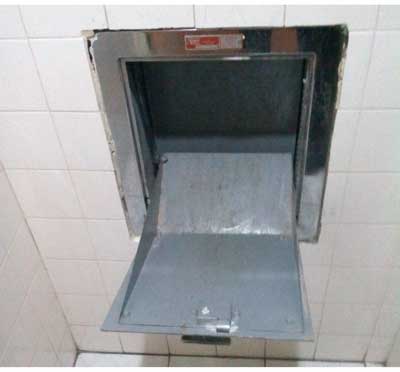
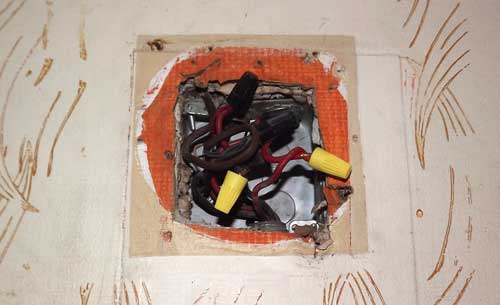
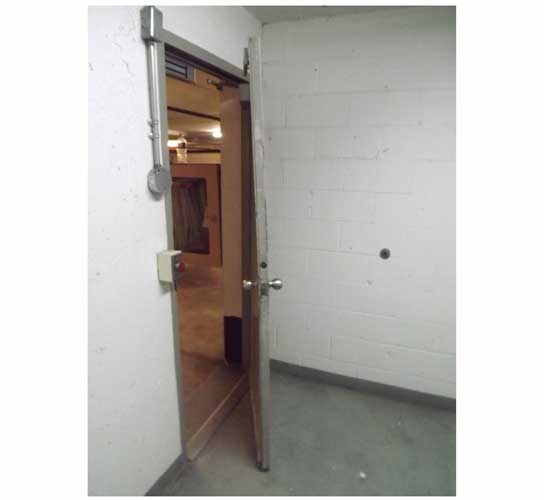
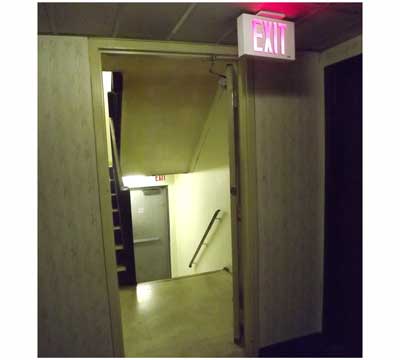
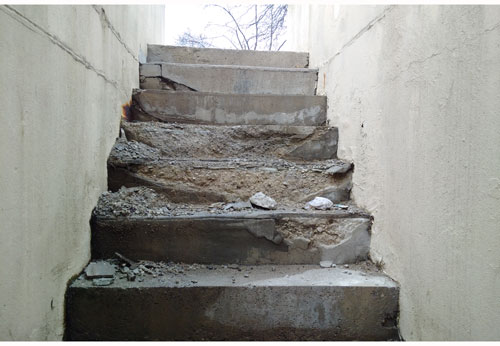
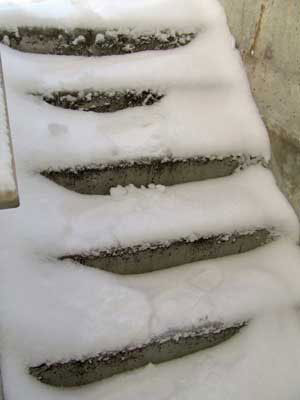
| 1. |
Immediately get everyone out of your
apartment. Make sure you and all your
family members are safe. This is most important. |
| 2. |
Close
the door behind you. This is very important as you need to contain the
smoke within your unit. Don't lock the door as the firefighters
have to get into your unit. |
| 3. |
Even if your smoke alarm is
going off, pull the fire alarm station closest to your unit. They are
next to the staircases. This will tell the firefighters where the fire
is. |
| 4. |
Once
you are in a safe position, call 911. Never assume someone else has
made the call or that pulling the fire pull station is sufficient. |
| 5. |
If it is a very small fire, and you are sure you know what you are doing, you can
try to put it out using one of the red
fire extinguishers that are in the hallways. There are two to three
fire extinguisher stations per floor. |
| 6. |
Do not use the white fire hoses. They are very hard to handle and put out tremendous amounts of dirty water. If the fire is so big that it needs fire hoses, it is far too dangerous for you to fight; so get out—fast. |
| 7. |
Do not stop to collect your valuables. Just get out. Remember, it is the smoke that usually kills, not the flames. |
| 8. |
Pets. This is a tough one. If
there is a fire and the alarm goes off, animals get scared. If you can
get your dog on a leach very quickly, without getting bit, then you may
be able to get him to follow you. Cats most likely will find a place to
hide. Don't waste time and risk your life trying to catch a badly frightened pet. |
| 9. |
Do not use the elevators. Leave by the nearest staircase. Put your hand on the door to test for heat before opening it. If there is smoke in the stairwell, use the stairwell at the other end of your hallway. |
| 1. |
Do not assume that it is a false alarm. |
| 2. |
Never use the elevators. (They should automatically drop to the ground floor.) If the electricity goes off, you will be trapped. If there is a real fire, you can die by smoke inhalation. You must use the stairs. |
| 3. |
Do not phone the front desk to ask what is going on. The telephone may be required by security to phone for assistance or talk to the fire alarm monitoring station. If you want to know what is going on, watch the TV lobby channel. |
| 4. |
The firefighters should inform you when they arrive and once they have completed their investigation, they should make a second announcement informing everyone that everything is back to normal. |
| This is a problem with older
condos that do not have an announcement system so the residents are not
informed of what is going on. |
|
| 5. |
If the firefighters or ambulance attendants are working, stay out of the their way. Leave the security guard and the superintendent alone too. These people need to be able to concentrate and work quickly. |
| 6. |
Don't hang around the lobby being in everyones' way. This is not a TV reality show. |
| aaa |
‘Staying in Place’ Another much-discussed aspect of the Grenfell Tower fire has been the ‘Stay in Place’—or ‘Stay Put’—policy, which is commonly used in high-rise residential fire safety procedures. “It’s an example of something that works really well provided all systems are functioning and the building is code-compliant,” says Reid. “In a typical fire scenario, the compartmentalization of the high-rise will effectively keep smoke and fire contained to the unit of origin and prevent it from spreading next door.” This works so well, in fact, that never in Ontario’s history has a fatality in a residential high-rise unit resulted from a fire that originated in another unit. All related fatalities were the result of residents trying to evacuate and getting trapped in smoke-filled stairwells and hallways. That said, according to Reid, still, the best thing to do in a fire is to leave the building immediately. “If residents make the decision to stay, or are unable to leave immediately, they need to protect in place. The longer occupants wait to make this decision, the more significant risk that heavy, toxic smoke will have spread into the stairwells and corridors,” he warns. “Fire Service response times for high-rise fires are estimated at about one minute per floor. If you’re on the fifth floor of the building, it’ll take approximately five minutes for rescuers to get to you. If you’re on the 20th floor, it will take an estimated 20 minutes. Residents need to be prepared to protect themselves in-suite and know how to do this prior to an emergency.” —Jason Reid, President National Life Safety Group |
| 1. |
Get everyone in the apartment together. Touch
your door to see if it is warm before opening the
door. If there is no smoke in the hallway, proceed to the closest staircase. |
| 2. |
Put your hand on the staircase door to test for heat before opening it. If there is smoke in the stairwell, try the stairwell at the other end of your hallway. |
| 3. |
If there is smoke in both staircases, go back and wait in your unit. |
| 4. |
Walk
down the staircase. Do not walk up to the roof. The doors leading to
the roof are locked. You could get trapped in the staircase. Remember,
smoke rises. Some condos have these signs on the staircase doors.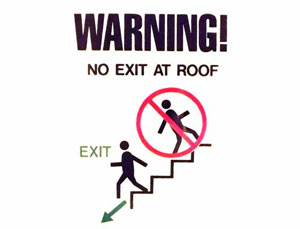 |
| 5. |
In
the newer condos, if you are in a staircase and you have to use the
other staircase, due to smoke or whatever, use the doors that say
"Crossover Floor." The electrical locks on those doors unlock when there is a fire alarm. |
| 6. |
At
the ground floor, exit the building and head for the designated Rally
Point. If you don't know where it is, then walk clear of the building
and wait for instructions. (Have your own Rally Point for your family.) |
| 7. |
Do not walk down to the underground garage to get your car. |
| 1. |
Stay in your apartment and wait
for an announcement from the
firefighters or the security guard working at the front desk. |
| 2. |
Use your high-rise survival kit. |
| 3. |
If
there is smoke in the hallway, duct tape around the door
frame to keep the smoke out. Put a wet towel under the door. |
| 4. |
Hang
a sheet outside your balcony and/or use a flashlight or the light on
your cellphone to alert the firefighters that your unit is occupied. |
| How to use the fire
extinguishers Remember PASS; Pull, Aim, Squeeze, Spray Pull out the pin in the handle. Aim the black hose at the fire. Squeeze the trigger. (It will be noisy.) Spray the chemical all over the flames. |
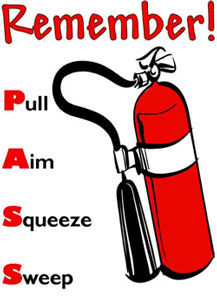 |
| High-rise survival kit The Toronto Fire Services recommends a high-rise survival kit for tenants of high buildings, readily available if they become trapped during a fire. You can purchase the following list of items for less than $50. Having these items available for emergency use may improve your chances of surviving a fire. |
|
| Wet towel | Place at the base of a door. |
| Duct tape | Tape over door and vent openings. |
| Foil wrap | Use to cover vent openings. |
| Whistle | Use to signal for help. |
| Flashlight | Use in case of power failure, smoke, or to signal for help. |
| Bright-coloured cloth | Hang up in a window, or on a balcony, to identify your location. |
| Ink marker | Use for messages on cloth, door or windows. |
| Cotton bed sheet | If smoke is heavy in your room, soak the bed sheet with water and make a tent near an open window. |
| Washcloth | Place the wet cloth over your mouth and nose to aid breathing in smoke-filled areas. |
| Fire safety plan | Have a copy of your building's emergency procedures available. |
| Plastic pail with lid | Use for storing survival equipment. (Fill with water during a fire.) |